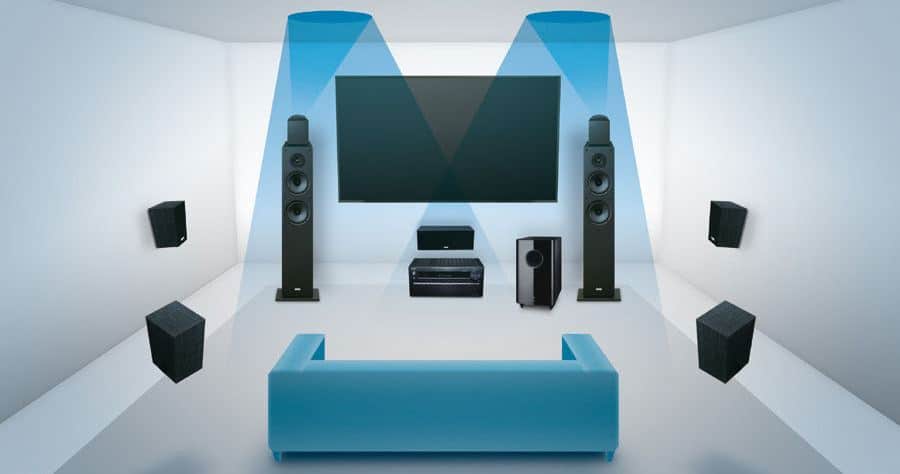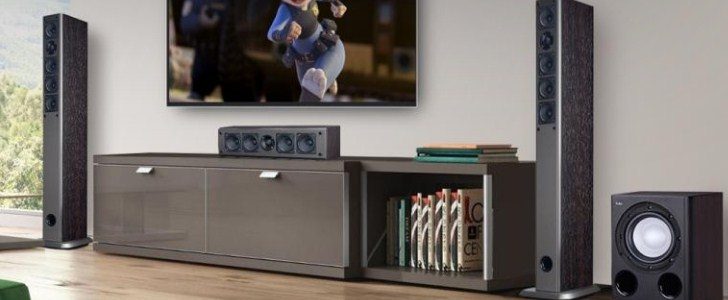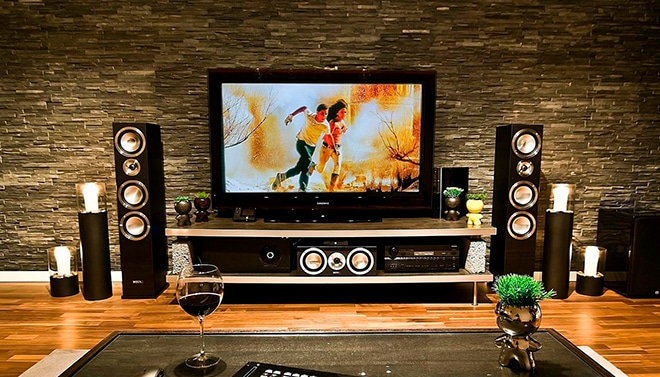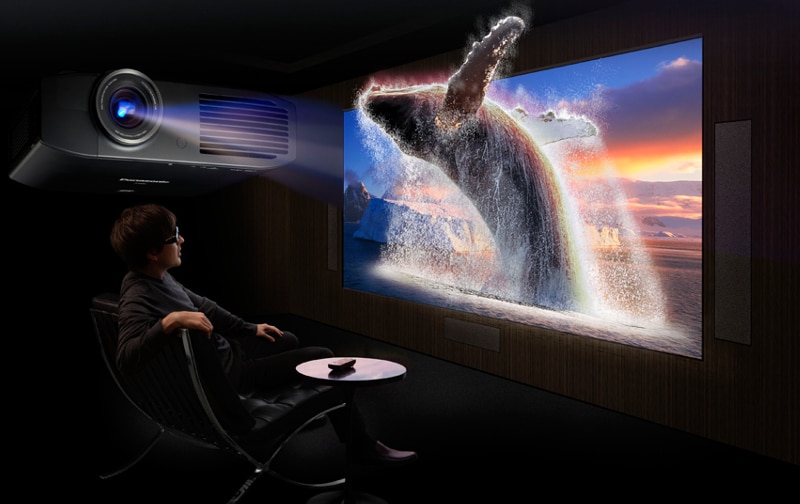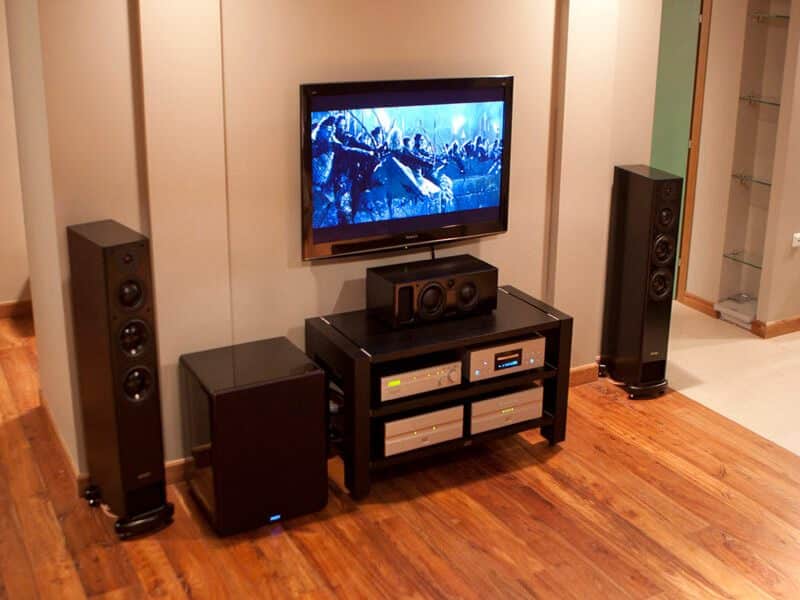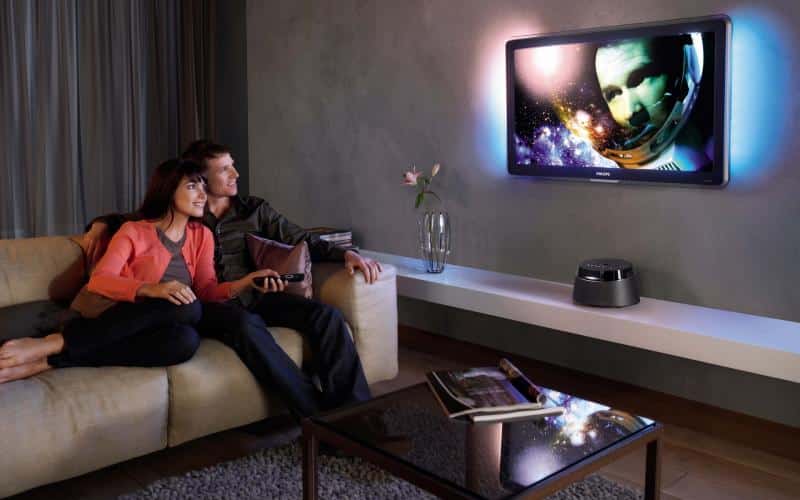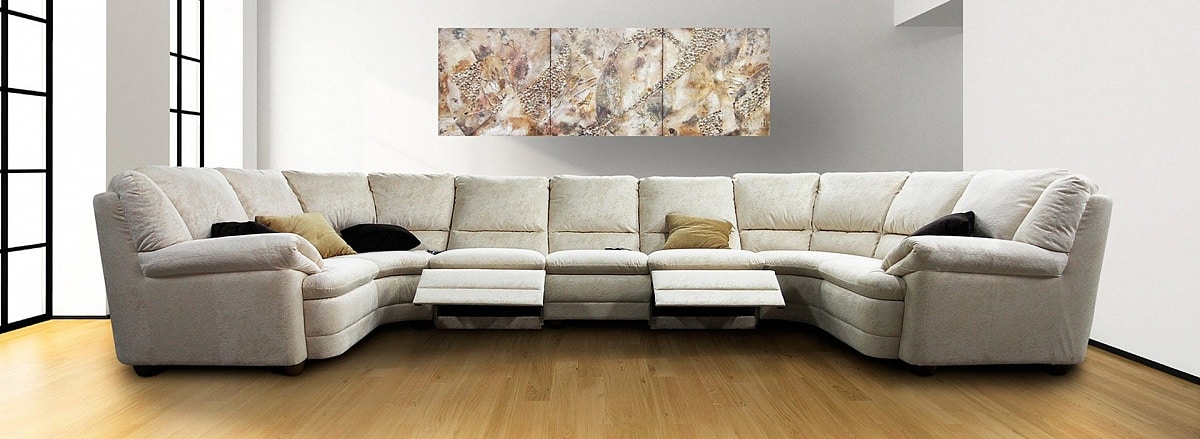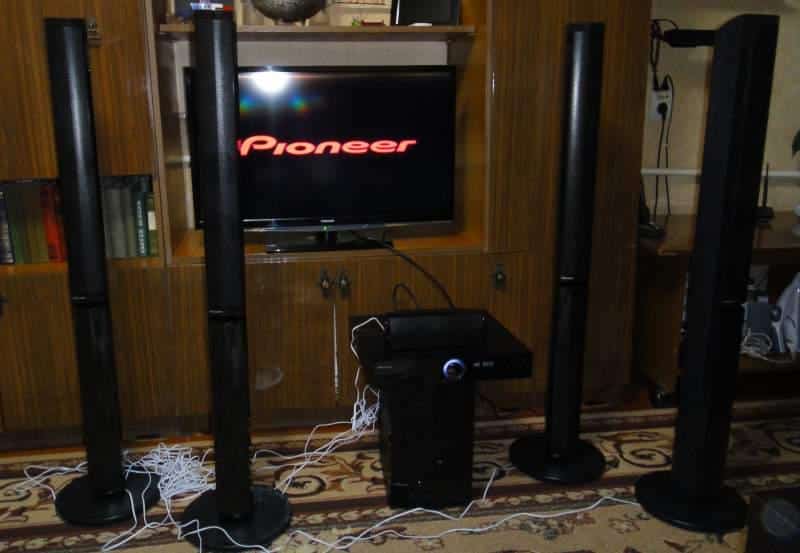Buying
a home theater has long ceased to be a luxury. Family watching movies at home, as close as possible to the conditions of the cinema, allows you to create a cozy atmosphere in which you can relax after a hard day’s work. However, in order to enjoy the quality of the picture and sound, it is necessary to choose a screen that matches the parameters of the room and correctly position the subwoofer.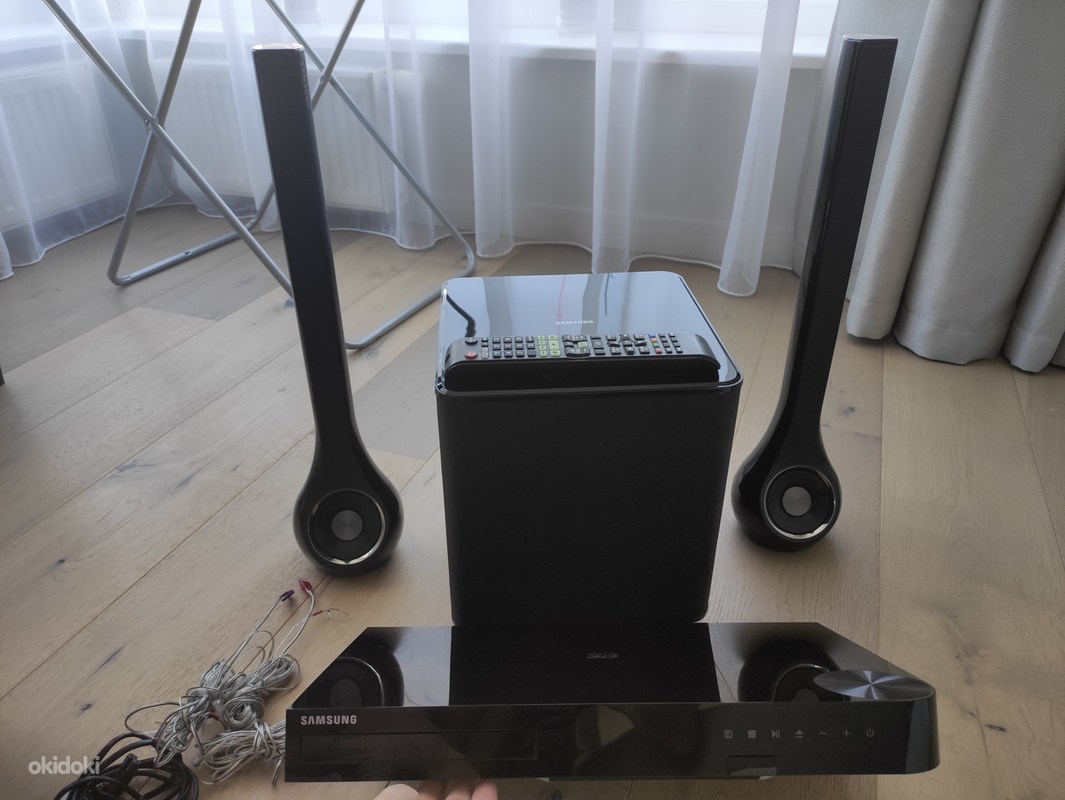
- What you need to know before you buy a home theater
- We select the acoustic system for your tasks, conditions, opportunities
- What components are needed
- The choice of a recreation center for a room – a room
- General rules for installing a home theater
- Initial home theater design
- What components are needed to assemble a DC
- How to assemble a home theater and connect a 2.1, 5.1 and 7.1 speaker system to a TV
- Arrangement of systems 2.1, 5.1, 7.1 in different rooms
- How to assemble a home theater yourself from the components included in the kit
- Assembly steps
- Connecting to a TV
- Home theater setup
- Possible problems and solutions
What you need to know before you buy a home theater
The composition of the home theater should include not only a TV, but also an acoustic system, a receiver, a DVD player. Such equipment allows you to fully enjoy watching movies in good quality. DVD player and acoustics can be purchased separately, or you can buy a complete set of equipment. It should be borne in mind that manufacturers supplement expensive sets with a receiver. When choosing speakers, you need to pay attention to the terms: 5.1, 6.1, 7.1, 9.1 meaning that the reproducing system has 5/6/7 or even 9 main speakers and a subwoofer. Note! Wall mounted speakers are capable of delivering the most realistic sound.
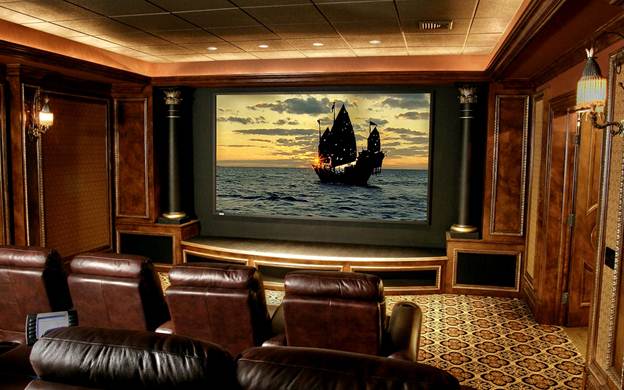 Installation of home theaters is a complex matter and design must be carried out carefully [/ caption] When choosing a home theater, it is recommended to pay attention to the sound power. If the room is small, then a total power of 100-150 watts is enough. In cases where the area exceeds 20 sq. m, it is advisable to purchase a kit whose total power exceeds 260 watts. As a rule, the cost of such equipment is 30-35% higher. When buying a DVD player, it is necessary to give preference to models whose sound processors are equipped with Dolby Digital and DTS decoders. Everyone chooses for himself that home theater model that meets all the requirements and satisfies personal needs. In addition, the design of the equipment should be taken into account so that it matches the interior of the room. Experts advise placing the screen in the central part of the room,
Installation of home theaters is a complex matter and design must be carried out carefully [/ caption] When choosing a home theater, it is recommended to pay attention to the sound power. If the room is small, then a total power of 100-150 watts is enough. In cases where the area exceeds 20 sq. m, it is advisable to purchase a kit whose total power exceeds 260 watts. As a rule, the cost of such equipment is 30-35% higher. When buying a DVD player, it is necessary to give preference to models whose sound processors are equipped with Dolby Digital and DTS decoders. Everyone chooses for himself that home theater model that meets all the requirements and satisfies personal needs. In addition, the design of the equipment should be taken into account so that it matches the interior of the room. Experts advise placing the screen in the central part of the room,
[caption id="attachment_6592" align="aligncenter" width="623"]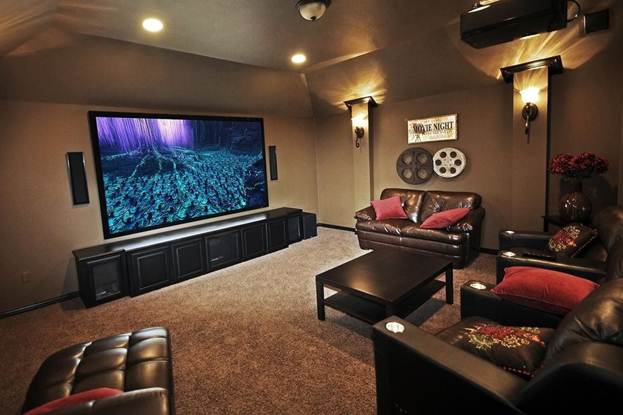 Wall-mounted speakers in the connection scheme will provide high-quality sound to your home theater
Wall-mounted speakers in the connection scheme will provide high-quality sound to your home theater
We select the acoustic system for your tasks, conditions, opportunities
Below you can get acquainted in detail with the features of choosing a home theater that will meet the tasks, conditions and capabilities of the user.
What components are needed
The main element of a home theater is an AV receiver – a device that combines the functions of a radio tuner, a multi-channel audio amplifier and a multi-channel sound decoder. Other equally important components of the system include: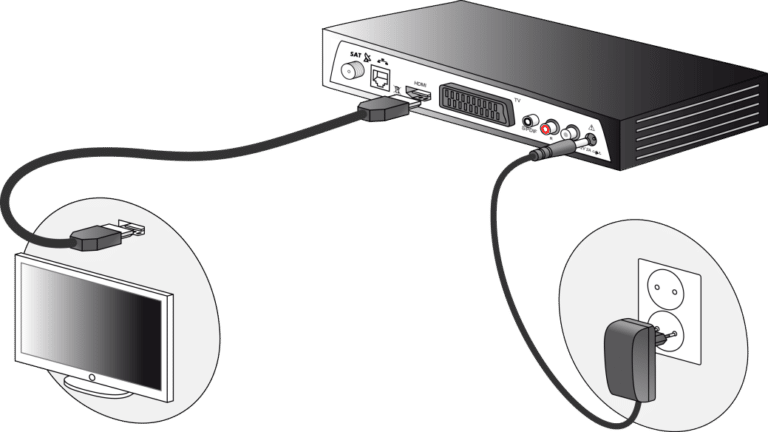
- monitor;
- acoustic system;
- sound and picture source (DVD player/video tuner).
A receiver is used to control and configure the cinema. The front speakers perform the functions of supplying the main sound and affect its quality. Floorstanding speakers work in/independently of a stereo system. Central acoustics is responsible for surround sounds and voice.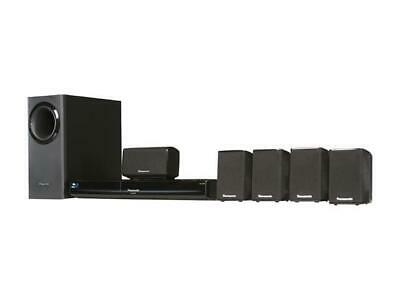 The subwoofer improves the sound. If you install it together with a satellite, you can achieve reproduction of medium and high frequency ranges. The rear speakers are placed directly above the audience’s head to create a sense of surround sound.
The subwoofer improves the sound. If you install it together with a satellite, you can achieve reproduction of medium and high frequency ranges. The rear speakers are placed directly above the audience’s head to create a sense of surround sound.
Advice! There is no need to install all types of speakers in one room
The choice of a recreation center for a room – a room
When choosing a home theater, it is worth considering the features of the room in which the equipment will be installed. When placing acoustics in a studio apartment, you should place the rear speakers on wall mounts. The speakers are turned towards the audience and slightly tilted down. If you do not plan to install rear speakers, you should purchase a 3.1/2.1 system and a subwoofer. The sound will need to be calibrated after installation is complete. In an L-shaped room, the rear speakers are placed behind the sofa, which is placed near the longest wall of the room. A monitor and a subwoofer with center speakers are placed in front of the audience. A 2.1 / 3.1 or 2.0 stereo system is suitable for such a room.
Advice! Do not allow speakers to be turned into a wall. It is also worth considering that the turn of the rear speakers should not be less than 110 °.
General rules for installing a home theater
Experts willingly share tips and rules for installing equipment with beginners.
- The room should be moderately muffled and have little effect on the sound.
- To eliminate the influence of external sources of noise, you can apply soundproofing .
- Adequate ventilation must be ensured when installing acoustic units .
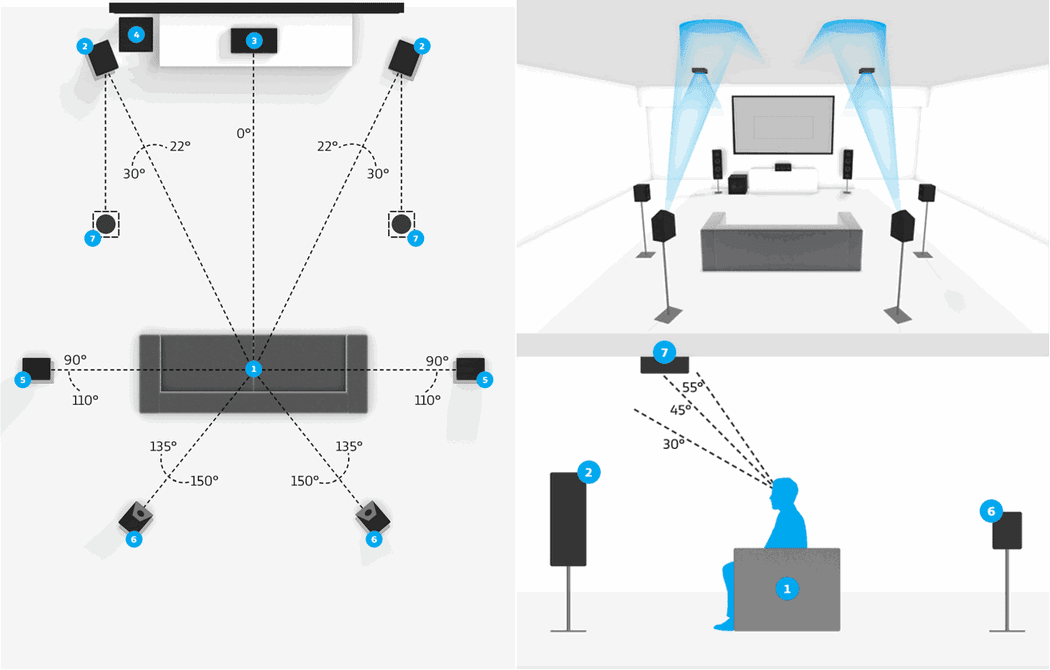
It is important to create comfortable conditions in the room that will not distract viewers from watching videos.
Initial home theater design
The process of designing a home theater is quite complex. The user must take into account not only the distribution and reflection of sound, but also the features of a particular room, providing sound and noise insulation. If you ignore these recommendations, then it will be impossible to achieve the desired result even if the most expensive equipment is installed. When embarking on the process of designing a home theater, it is important to learn the principle of building a cinema. The image transmitted by a digital/analogue film projector to a monitor made using a special technology allows you to achieve a sharp and clear picture. The monitor must pass sound from the subwoofer and center channel without loss.
Note! To add power/rumble/bass depth, use a subwoofer while watching a video.
What components are needed to assemble a DC
Home theater components must be compatible with each other. When choosing a DC, you should give preference to high-quality models, the use of which allows you to achieve a clear image and clear sound. If you want to buy a home theater in which the equipment will be perfectly combined with each other, you should take care of purchasing:
- projection screen Vutec;
- SIM2 projector;
- acoustic system PMC;
- McIntosh amplifier;
- OPPO DVD player;
- karaoke Evolution Lite2 Plus;
- Apple TV media player.

- HDMI;
- component (component, RGB);
- coaxial COAXIAL;
- SCART;
- S video
- analog, which is called a tulip / bell.

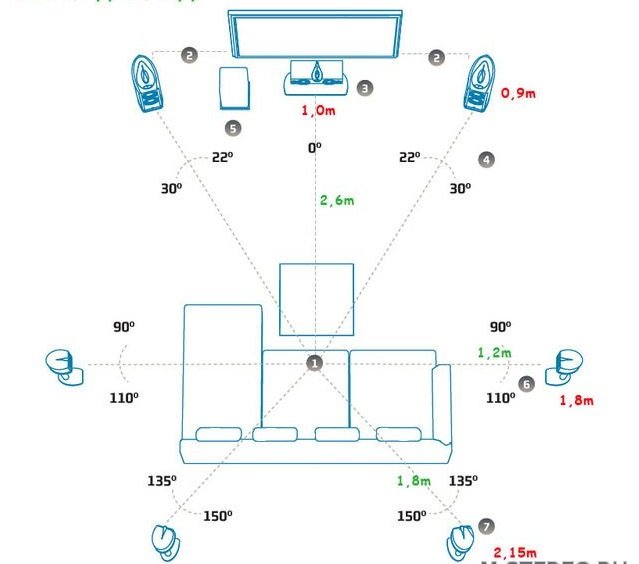
How to assemble a home theater and connect a 2.1, 5.1 and 7.1 speaker system to a TV
If you wish, you can assemble a home theater on your own, having previously studied the rules, connection diagrams and allocating a little time. Before proceeding with the connection of the equipment, it is necessary to correctly place all the components of the equipment, paying attention to the main points:
- The screen size must be selected taking into account the area of the room in which it will be located. Using a small diagonal monitor will not allow you to fully enjoy watching a movie.
- The subwoofer, receiver and DVD player are installed in the center under the monitor.
- The installation of the projector / TV is carried out at the level of the viewers’ eyes.
Acoustics should be positioned in such a way that the audience is in the central part of the room.
Below you can see the installation diagrams of systems 2.1, 5.1 and 7.1. Self-installation of a 5.1 home theater according to the scheme: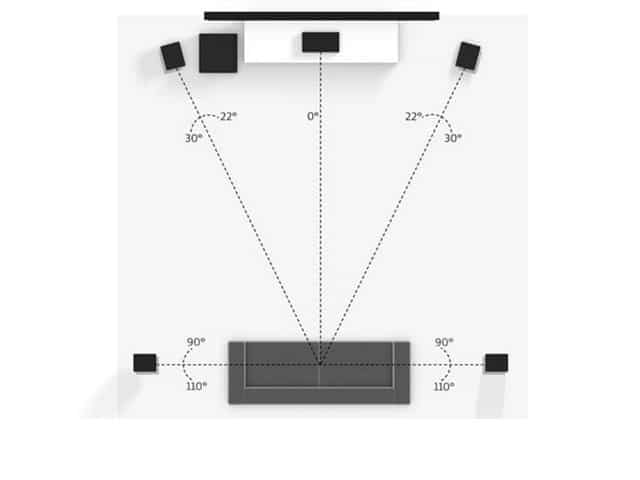 System 7.1 – placement of home theater components
System 7.1 – placement of home theater components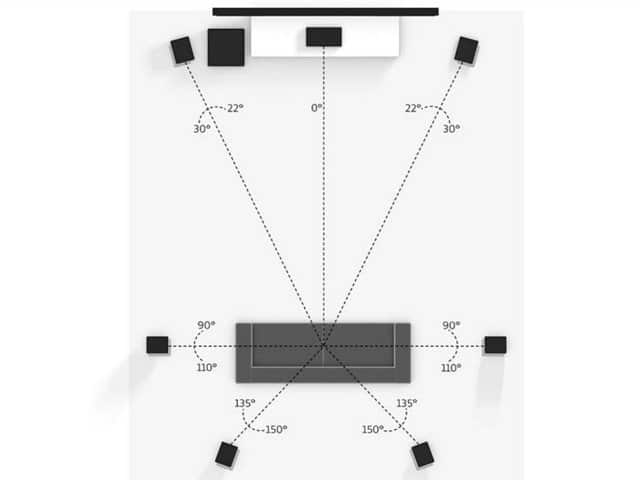 System 2.1 – an easy installation method:
System 2.1 – an easy installation method: Installation of a home theater – system 9.1:
Installation of a home theater – system 9.1: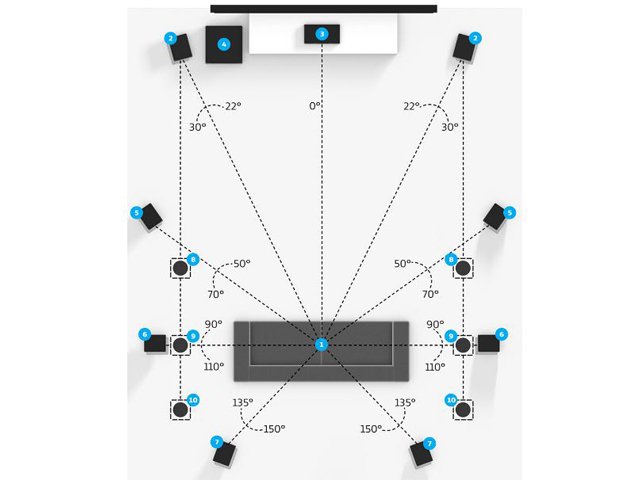 Installation of home theaters – three basic rules for installing acoustic systems: https://youtu.be/ BvDZyJAFnTY
Installation of home theaters – three basic rules for installing acoustic systems: https://youtu.be/ BvDZyJAFnTY
Arrangement of systems 2.1, 5.1, 7.1 in different rooms
Not every room can achieve surround sound. In order to achieve good sound, it is necessary to consider the type of room and the system that is ideal for it:
- For an L-shaped room, a 5.1 system is perfect. For better sound quality, you should move the sofa away from the wall and place the TV in the corner.
- Studio room . In this case, it would be reasonable to give preference to the 3.1 system. Speakers must be built-in ceiling. They are placed behind the sofa.
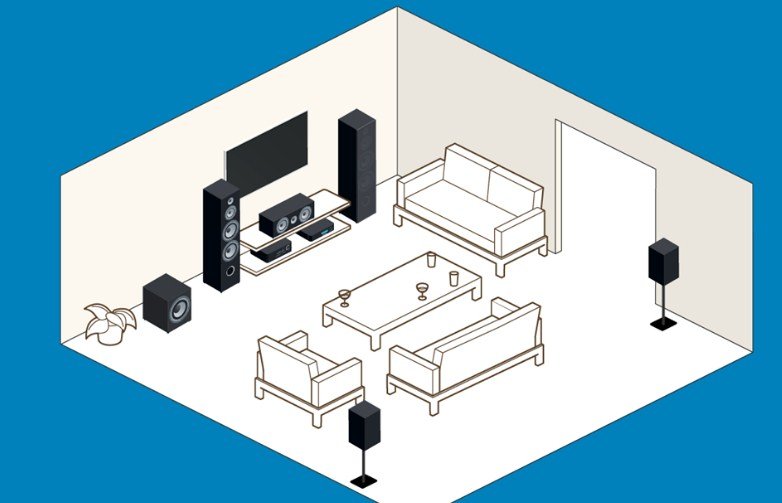
Location of the home theater in the studio room - For a spacious rectangular room, you will need to purchase a 7.1 system. Speakers are placed on both sides of the monitor and behind the sofa.
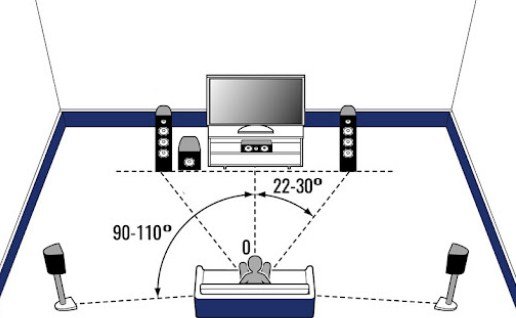
How to assemble a home theater yourself from the components included in the kit
In order to assemble a home theater with your own hands, you will need to purchase not only a projector, but also a sound structure / computer / monitor / filters.
Assembly steps
By following the step-by-step instructions, you can avoid the mistakes that often occur during the assembly process. Step 1 First of all, you need to purchase an LCD projector (resolution 1280 * 720 pixels / brightness – 1600 lumens). The contrast ratio of the projector should reach 10000:1. To achieve good sound, you need to buy several speakers and place them in different parts of the room. Speakers are placed on the floor or mounted to the wall. You will also need an adapter with wires.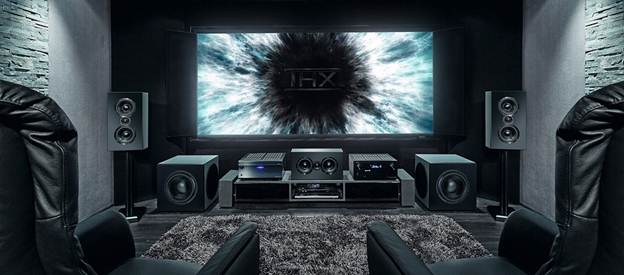 Stage 2 The wires from the speakers are removed under the plinth.
Stage 2 The wires from the speakers are removed under the plinth.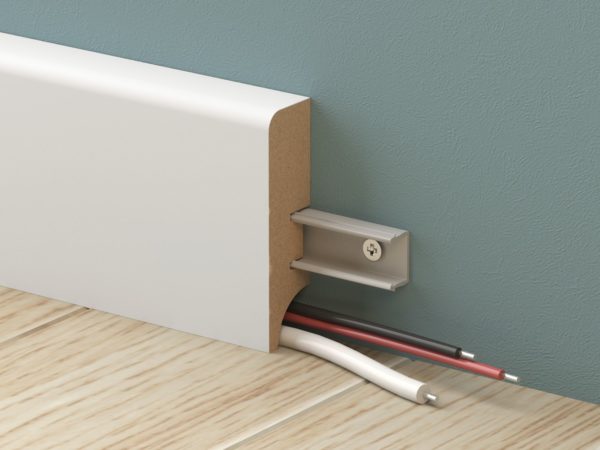 Step 3 The adapter is connected to one side of the wire leading to the subwoofer. The second is connected to the cable from the column. A central column is installed on top of the screen. Stage 4 The subwoofer is placed on the side of the screen and a wire is pulled from it
Step 3 The adapter is connected to one side of the wire leading to the subwoofer. The second is connected to the cable from the column. A central column is installed on top of the screen. Stage 4 The subwoofer is placed on the side of the screen and a wire is pulled from it
to connect to a computer / laptop.
Note! A computer is needed in order to display the image on the screen.
 Step 5 The computer is connected via DVI. The screen is fixed to the wall using special fasteners. Step 6 Attach the projector to the ceiling. To do this, you need to use a special hose.
Step 5 The computer is connected via DVI. The screen is fixed to the wall using special fasteners. Step 6 Attach the projector to the ceiling. To do this, you need to use a special hose.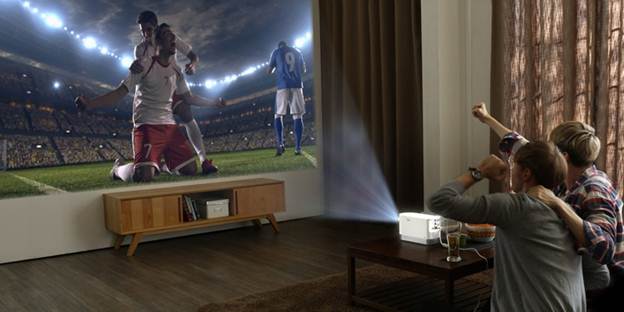 Also, do not forget that you need to hang filters on the windows, which will reliably protect against the penetration of light. By independently forming a complex, you can save an impressive amount of money. How to assemble, connect and set up a home theater – from design to placement and connection of all components into a common system of acoustics and Smart TV TV: https://youtu.be/AgjIQM5QMl4
Also, do not forget that you need to hang filters on the windows, which will reliably protect against the penetration of light. By independently forming a complex, you can save an impressive amount of money. How to assemble, connect and set up a home theater – from design to placement and connection of all components into a common system of acoustics and Smart TV TV: https://youtu.be/AgjIQM5QMl4
Connecting to a TV
There are many options for connecting a home theater to a TV. Below you can find the main ones:
- Through the headphone jack . To do this, you will need to use a miniJack 3.5 mm slot. Most television receivers have a similar socket. To connect the equipment, you will need a special cord, on one side of which there will be a miniJack tip, and on the other side, a pair of RCA “tulips”.
- Through the SCART socket . Some TV models have a SCART interface output, and RCA in home theaters. You can connect the “non-pair” using a special cable, on one side of which there is a SCART connector, and on the other – a pair of RCA “tulips”.
- HDMI OUT is the best option. To connect, you will need to find an HDMI IN slot on the back of the DC receiver (the port may be marked ARC). Next, the user goes to the settings category on the TV and selects the option to play sound through the playing audio/voice for acoustic system. The playing audio/voice for dynamic checkbox is unchecked.
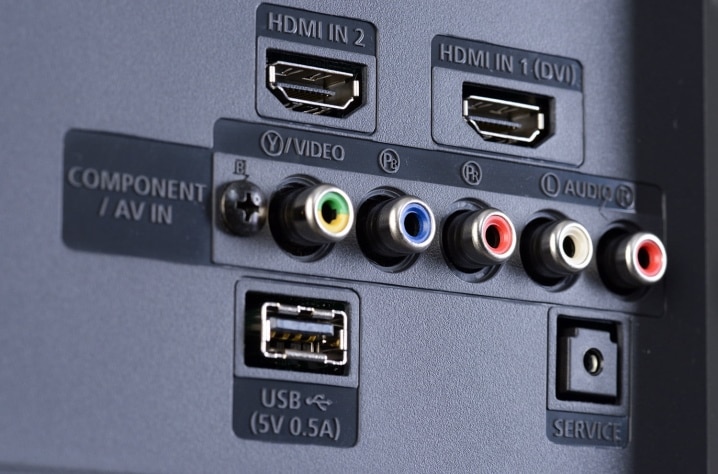 Scheme for connecting a home theater to a TV:
Scheme for connecting a home theater to a TV: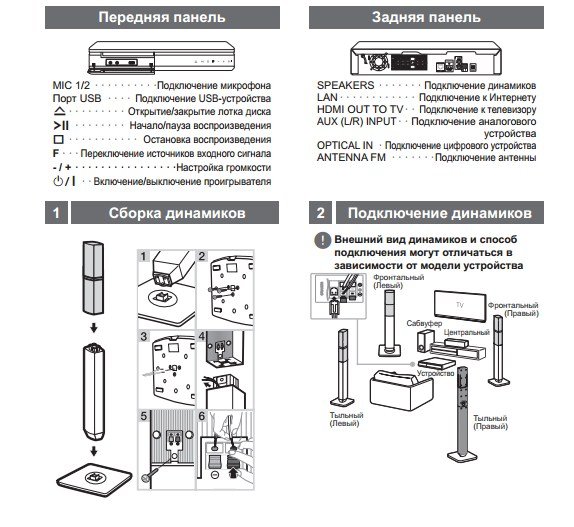
Note! If you prefer the headphone jack connection method, you should be aware that the sound quality will be lower than with other methods. Therefore, experts advise using this method only as a fallback.
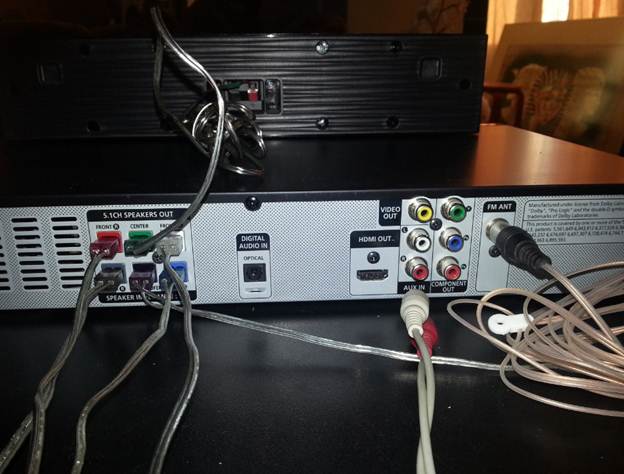
Home theater setup
In order for a home theater to please with good sound, you should not only place the speakers in the room correctly, but also take care of setting the sound of the equipment. Starting the setup, you need to arrange the speakers in a circle in the resulting space between the audience and the screen. To avoid sound distortion, do not place speakers too close to walls. Through system configuration, home theater owners configure the equipment:
- First of all, the user selects the bass sound mode from the center speaker.
- If the speaker is too large, you will need to select the Wide mode for optimal bass performance.
- In the case when the loudspeaker is placed on the central video player, experts advise setting the Normal mode.
- When tuning the center channel, set the delay time. For every 30 cm difference between the equipment and the listener, a delay of 1 ms is set. The delay time can be omitted when the front speakers are arranged in an arc.
- Next, select the desired volume level of the channels, which can be adjusted using the volume control of the receiver.
- While adjusting the brightness level, 32 shades of gray with clear borders can be seen at the bottom of the image. Shades merge with dark areas in case of low brightness.

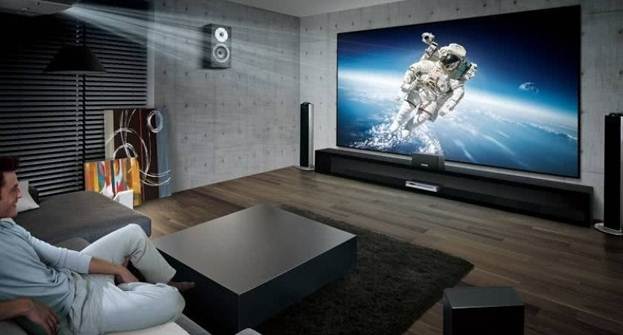
Possible problems and solutions
In the process of connecting a DC, users often have problems. The most common difficulties and how to solve them can be found below.
- Poor audibility of voices and strong bass . As a rule, such a nuisance occurs in cases where hard flooring is used. To solve the problem, you need to lay a carpet on the floor.
- A muffled sound indicates that there is a lot of upholstered furniture in the room or the acoustics are incorrectly selected. In order for the sound to be surround, it is necessary to hang photo frames / pictures on the walls on both sides of the subwoofer.
- Chattering sound is a fairly common problem, for which it is enough to move the speakers away from the walls. You will also need to install upholstered furniture in the room.
- Difficulties associated with connecting a cinema to a PC . It is best to give preference to the wireless connection method. Wi-Fi must be built into the cinema system. Using wireless communication, it will be possible to connect the DC not only to a computer, but also to a laptop / smartphone / tablet.
Note! On sale you can find models of home theaters, which are controlled through a smartphone on which a special application is installed.

